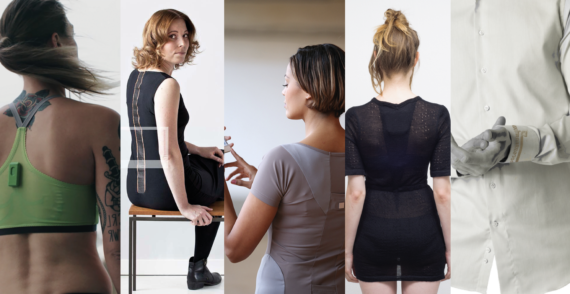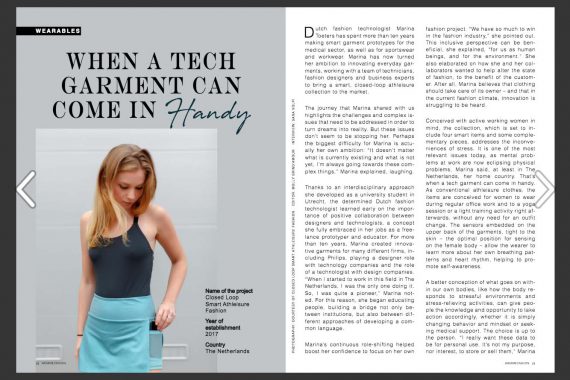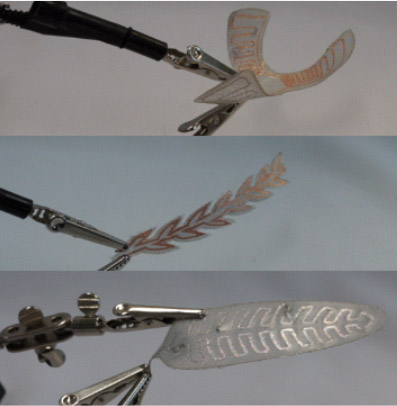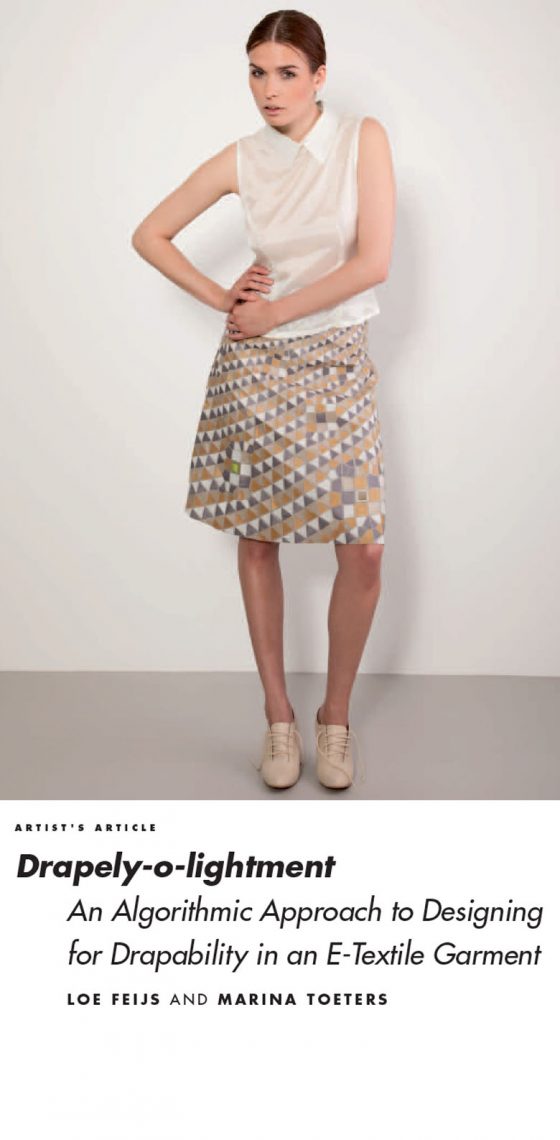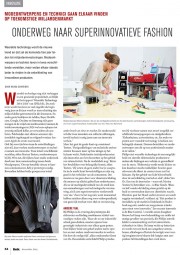downloads
Popular media and scientific publications are mixed in this download part. Contact by-wire.net for more information or additional documents.
e-stitches – E-Textiles Conference magazine
 Download here: e-stitches – E-Textiles Conference – Berlin 2024
Download here: e-stitches – E-Textiles Conference – Berlin 2024
Apollonial for Bridges 2022 with LAURENTIUS LAB
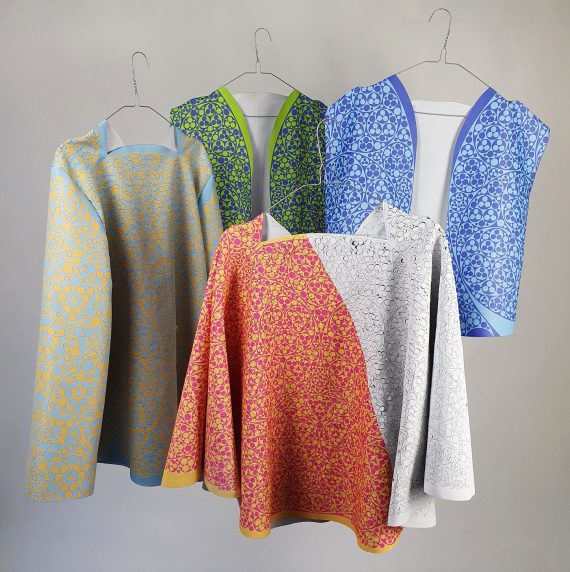
A circle is one of the most symmetric shapes we know. More than 200 years ago, Apollonius of Perga explored configurations of “kissing circles”. In between three kissing circles there is a fourth, which fits perfectly. And ten another, and yet another, the process simply does not stop.
Here the link to the Bridges website to learn more. Or a direct link to the paper download:
https://archive.bridgesmathart.org/2022/bridges2022-119.pdf
read more
Bridges 2020 paper: Design of a Sampler of Isohedral Tilings of the Pied-de-poule Tile
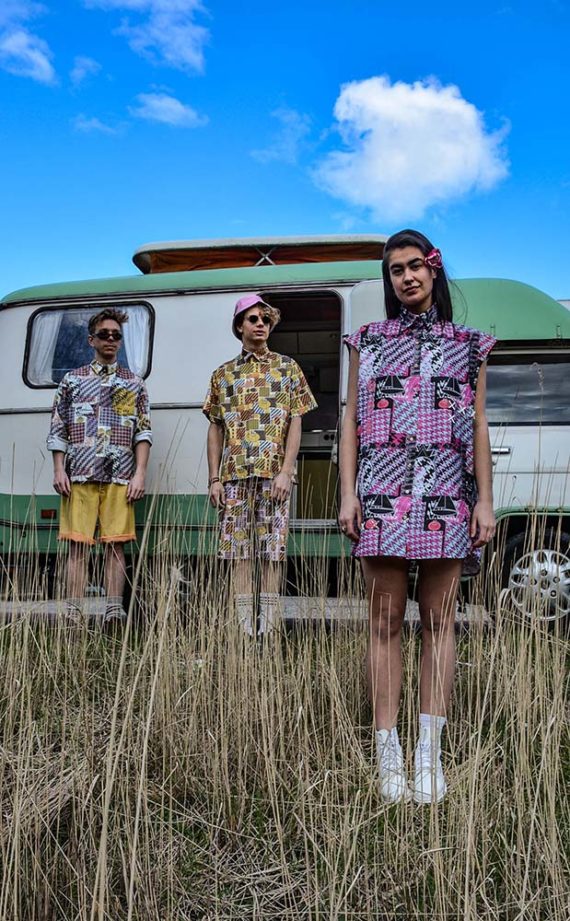 Abstract: We describe the design of a sampler of all isohedral tilings of the classic pied-de-poule tile. The sampler is a Hawaiian shirt, also known as Aloha shirt. This allows us to explore the wider applicability of the pied-de-poule motif, yet respecting the design principles of classic Hawaiian shirts. We formulate the precise inclusion and exclusion criteria of the set of tilings to be enumerated. By checking the various combinations of symmetries, we find that there are eight distinct tilings, to be included in the sampler. We also show representations of the three orbifolds of the corresponding symmetry groups, which are added to the shirt in the form of phantasy sea creatures, based on a torus, a Klein bottle and a twisted pillow.
Abstract: We describe the design of a sampler of all isohedral tilings of the classic pied-de-poule tile. The sampler is a Hawaiian shirt, also known as Aloha shirt. This allows us to explore the wider applicability of the pied-de-poule motif, yet respecting the design principles of classic Hawaiian shirts. We formulate the precise inclusion and exclusion criteria of the set of tilings to be enumerated. By checking the various combinations of symmetries, we find that there are eight distinct tilings, to be included in the sampler. We also show representations of the three orbifolds of the corresponding symmetry groups, which are added to the shirt in the form of phantasy sea creatures, based on a torus, a Klein bottle and a twisted pillow.
DIS 2020 paper: Designing Towards Inward-Oriented Fashion Technology
Fashion technology designs typically combine sensing technology and actuators to register and respond to information about the environment and/or the human body. The ways in which designers use and integrate these data into garments, however, varies on a scale from highly theatrical and outward-oriented designs to subtle and inward-oriented applications.
Publication International Journal of Design
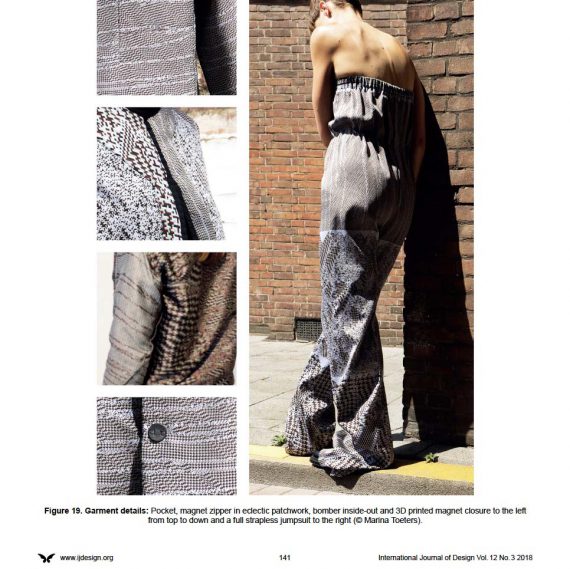 At the last day of 2018 we received the message that the paper of Loe Feijs and me is published in the International Journal of Design!
At the last day of 2018 we received the message that the paper of Loe Feijs and me is published in the International Journal of Design!
wearme.fashion article about CLSAF
Sara Volpin wrote a great article about Closed Loop Smart Athleisure Fashion. Download the pdf here or check this digital publication from page 58 on: The Smart Issue #3
ShapeTex paper presentation @TEI2018, Stockholm
Is was a great pleasure to present the paper ShapeTex: Implementing Shape-Changing Structures in Fabric for Wearable Actuation
More info: https://dl.acm.org/authorize.cfm?key=N43354
Publication eTNO Berichten
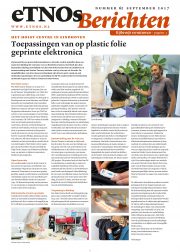
Wim Bergers wrote the lovely article (in Dutch) about applications of printed electronics. He interviewed Corné Rentrop @Holst Centre and Marina Toeters @by-wire.net for this. Download here the total pdf file >>
read more
International Symposium on Wearable Technologies (ISWC’16)
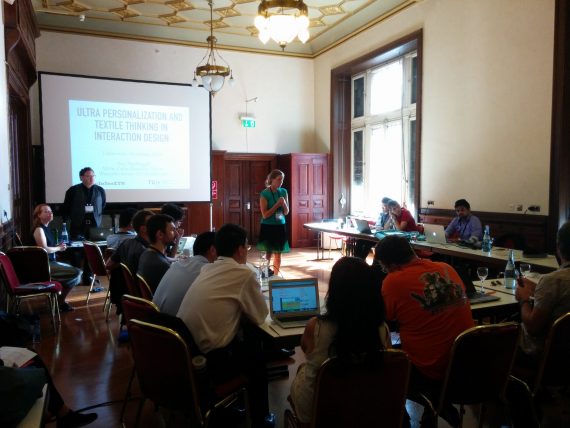
Download our paper in the ACM Digital Library [search for Marina Toeters]
read more
Featured in LEVEN
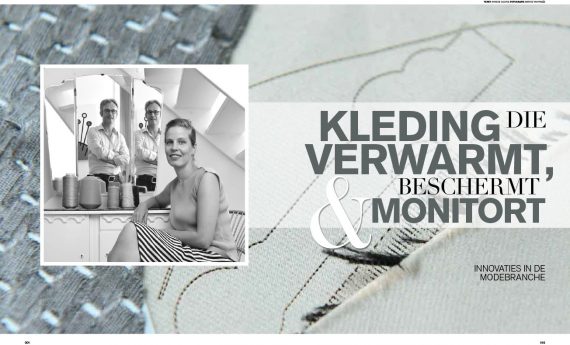
Download here the pdf >>> [in Dutch]
Thanks to: Annette van Herk, Leven Magazine. Text: Anneke Gilsing. Photo’s: Marike van Pagée
read more
Leonardo publication • Design of Drapely-o-lightment
A Novel Line Fractal Pied de Poule (Houndstooth)
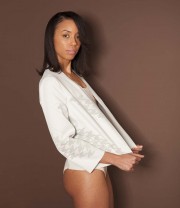
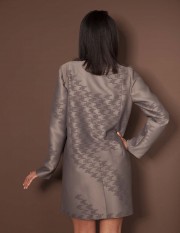
In earlier work Loe Feijs and Marina Toeters proposed a fractal pied de poule inspired by Cantor’s dust, building on a mathematical analyis of the classical pied de poule pattern (fPDP). Now we propose another fractal pied de poule implemented as a single line.
We calculate the fractal dimension and develop a fashion item based on the new pattern, to be shown at Bridges, Baltimore USA. Download here the paper >>
read more
2007 master thesis: collaboration in fashion technology
 This is were is all started: my study fashion design at the Master department of the Utrecht School of Arts.
This is were is all started: my study fashion design at the Master department of the Utrecht School of Arts.
How to create collaboration between technicians and designers in the fashion world? The starting point of by-wire.net was the Master thesis of Marina Toeters for the MaHKU (Master Utrecht School of Arts). Several companies helped Marina during experiments with design and development processes. From this 6 garments were produced: Huggy Care, Tecatud, Triangled Coat, Fire Fighter Suit, Ecological Suited, Dyna Seat Dress.
The process was analysed and conclusions made: ‘Collaboration is difficult. Some experiments identify problems that appear along the way. Communication is hard. ‘For a successful collaboration you have to speak the same language.’ (Vertooren 2007)
This can be created by shared experiences and references or learned by education, but ‘understanding of technology is rapidly disappearing at design training institutions,’ said Ed van Hinte (2006).
‘Fashionable clothing hyperventilates.’ (Robaard 2004) Technical companies produce slower. They experience time completely different. Knowledge about this is essential without ending in a disappointment.
Technical companies don’t like to work with several partners. Secrecy is everything! Last pitfall is that most companies focus either on (fashion) design or technical developments. It is difficult to create a collaborative design if you don’t physically work together.
A collaboration platform can solve some pitfalls. by-wire want to create a place where technicians and designers fuse together and start truly interdisciplinary projects with added benefits to society.
2014 Design of a nature-like fractal celebrating warp knitting.
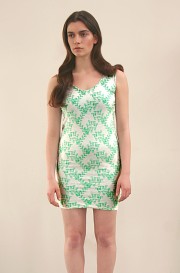
Proceedings of Bridges 2014: Mathematics, Music, Art, Architecture, Culture (2014)
Pages 369–372 Download the total paper here. Or find more about the art exhibition here.
Abstract In earlier work Feijs and Toeters created a new textile pattern which was derived from the well-known houndstooth pattern which originates from weaving with twill binding. The new pattern became interesting, both mathematically and aesthetically because it was a fractal. Now we are turning our attention to another basic fabric construction method: warp-knitting. We developed a recursive algorithm and explore the properties of the result. We also develop an attractive fashion item based on the new pattern, presented at Bridges Seoel, South Korea.
2014 Transforming the Dance Experience with Expressive Social Wearables
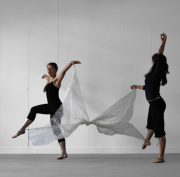
Final Master research by Theodora Kyrgia @TU/e. Marina Toeters coached her during this process. Paper by Thodora Kyrgia and Marina Toeters. A Global Network for Dynamic Research and Publishing, presented by Theodora during the 5th Global Conference. Session 9: Performances of All Senses: Bodies in Creative Action and Interaction. Download the complete paper here.
Abstract (…) the dancer’s body becomes by default the expressive instrument of the action but also the receiver of attention during the performance.
Interaction design has long been involved with wearable pieces that include technology, translating physical body movement into other modalities, complementing and enriching the performance. These body artefacts can engage people’s imagination, creativity and critical thought, due to their expressive abilities, depending on the performers’ movement. (…) the connected bodies become an active interface, open to self expression, exploration and playfulness, enriching the performance experience both for participants and audience.
2014 Designing a Country publication


Societies the world over are facing enormous challenges today.
The economic crisis has left its mark on them. Their populations are ageing; and the fossil fuels on which they run are becoming scarcer.
Population growth has put pressure on the quality of life, infrastructure and environmental quality of cities worldwide. But there is good news too.
The Netherlands is actively helping to face these global challenges.
This booklet shows some examples how The Netherlands reacts on this via their creative industry. by-wire.net fills 6 pages totally in the end of the booklet. Download the publication.

2014 Models for Successfully Applying Space Technology Beyond Its Original Intent

Paper by Dr. Irene Lia Schlacht, Prof. Bernard Foing, Prof. Annalisa Dominoni, Mr. Bruno Naulais, Marina Toeters MA., Mr. Frans Blok, Mr. Kent Nebergall, Dr. Jean-Marc Salotti, Dr. Alexandre Mangeot, Prof. Olga Bannova, Dr. Ayako Ono, Mr. Antonio Olmedo Soler, Mr. Hans van ’t Woud, Prof. Melchiorre Masali
65th International Astronautical Congress, Toronto, Canada. Copyright ©2014 by Irene Lia Schlacht. All rights reserved. Download the complete paper here.
Abstract. Many R&D organizations look for ways to demonstrate the value of their technology portfolio to educate as well as accommodate a broad community of onlookers and users. Academia- and government-sponsored space programs need to depict how their science and technology activities are relevant to technology transfer, knowledge sharing, and technology commercialization. Papers will explore a variety of approaches that organizations can adopt for the successful transfer of technologies that impact new products and services for space and non-space applications. Relevant legislation, business structures, models, metrics, and alternative technology transfer models will be discussed. Papers will provide examples of successful models with descriptions of the approach and tools used, results to date, issues addressed, and ongoing changes made.
2014 E-Textile Swatchbook Exchange (2013)
Abstract The E-Textile Swatch Exchange is a platform for sharing physical work samples in the field of electronic textiles.
The exchange wishes to emphasize the importance of physicality and quality workmanship in an increasingly digital world. Individuals and collaborative efforts participate in the exchange by submitting a unique swatch design of their own, and in turn receive a compiled collection of everybody else’s swatches. This means that everybody participating needs to make as many multiples of their swatch as the total number of participants. There are no guidelines defining what the swatches could or should be, only that they relate to the field of E-Textiles. Download the total paper here.
Or find the extensive visual explaination here.
And a lot of information via the E-textile Summercamp website.
2013 Research through design: a way to drive innovative solutions in the field of smart textiles
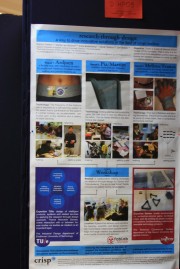
Paper by Marina Toeters, Martijn ten Bhömer, Eliza Bottenberg, Oscar Tomico, Ger Brinks. Saxion University of applied science Enschede (Saxion), Technical University Eindhoven (TU/e), The Netherlands
Abstract Research through design allows creating a dialogue with the material. It uses making and reflection on action as a generator of knowledge. Our aim is to explore the opportunities and challenges of smart textiles. The Fablab is our set up, a place that allows us to combine the hackingscientific-, and design community. It stimulates collaboration and the knowledge exchange needed for the development of smart textile systems. A collaborative prototyping workshop for medical
products combined two worlds. The textile world in Saxion aims at incorporating conductive materials into textile structures and functional- / 3D printing to create systems for applications such as flexible heating systems and wearable technology. We combined this with the world of Industrial Design at TU/e, focused on the design of intelligent products, systems and services by the research through design approach. The collaboration between these different disciplines accelerated the process by reducing the resistance to the new and skipped the frustration on failure. Download the complete paper here.
2012 Analysis of parallel collaboration assignments in smart textile design

Marina Toeters and Ger Brinks from the Saxion Lectoraat Smart Functional Materials presented this paper during the ‘Onderzoek voor een vitale regio’ congress 2012.
Abstract To investigate the different kinds of expertise necessary for the development of Smart Textile Services we initiated an assignment to develop new Smart Textile Services concepts for elderly that can be used during rehabilitation (ten Bhömer, et all 2012) and executed this project in 2 different institutes: Saxion University of Applied Sciences and Eindhoven University of Technology.
The blue dots are the activities. Horizontal is the timeline from the -left- beginning till the end of the process. The 6 competences are placed on the vertical line:
1. User Focus & Perspective: Getting to know their user.
2. Ideas & Concepts: Creating ideas and transform them into concepts.
3. Social & Cultural Awareness: Reflect on context and existing products.
4. Form & Senses: Design explorations for the actual products.
5. Integrating Technology: Research, develop and implement (existing) technology.
6. Business: Find out how to create a valuable business with the project.
Download the full paper.
2011 Disseminating knowledge of electronic textiles at art schools and universities
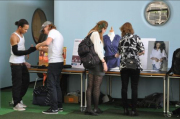
Authors: Melissa Coleman, Michel Peeters, Ms. Valérie Lamontagne, Linda Worbin, Marina Toeters
Abstract This paper aims to give an impression of how knowledge of e-textiles is shared in art schools and universities. With this paper, we intend to create a context for future reflections on e-textiles education and knowledge dissemination for educators in this field. We hope to stimulate knowledge sharing on e-textiles between institutes and with the e-textiles community at large by identifying opportunities for open learning.
Presented by Melissa Coleman and ISEA 2011. Here more information.


